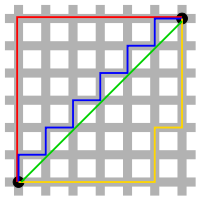
In mathematics, a metric space is a set together with a notion of distance between its elements, usually called points. The distance is measured by a function called a metric or distance function.[1] Metric spaces are the most general setting for studying many of the concepts of mathematical analysis and geometry.
The most familiar example of a metric space is 3-dimensional Euclidean space with its usual notion of distance. Other well-known examples are a sphere equipped with the angular distance and the hyperbolic plane. A metric may correspond to a metaphorical, rather than physical, notion of distance: for example, the set of 100-character Unicode strings can be equipped with the Hamming distance, which measures the number of characters that need to be changed to get from one string to another.
Since they are very general, metric spaces are a tool used in many different branches of mathematics. Many types of mathematical objects have a natural notion of distance and therefore admit the structure of a metric space, including Riemannian manifolds, normed vector spaces, and graphs. In abstract algebra, the p-adic numbers arise as elements of the completion of a metric structure on the rational numbers. Metric spaces are also studied in their own right in metric geometry[2] and analysis on metric spaces.[3]
Many of the basic notions of mathematical analysis, including balls, completeness, as well as uniform, Lipschitz, and Hölder continuity, can be defined in the setting of metric spaces. Other notions, such as continuity, compactness, and open and closed sets, can be defined for metric spaces, but also in the even more general setting of topological spaces.

To see the utility of different notions of distance, consider the surface of the Earth as a set of points. We can measure the distance between two such points by the length of the shortest path along the surface, "as the crow flies"; this is particularly useful for shipping and aviation. We can also measure the straight-line distance between two points through the Earth's interior; this notion is, for example, natural in seismology, since it roughly corresponds to the length of time it takes for seismic waves to travel between those two points.
The notion of distance encoded by the metric space axioms has relatively few requirements. This generality gives metric spaces a lot of flexibility. At the same time, the notion is strong enough to encode many intuitive facts about what distance means. This means that general results about metric spaces can be applied in many different contexts.
Like many fundamental mathematical concepts, the metric on a metric space can be interpreted in many different ways. A particular metric may not be best thought of as measuring physical distance, but, instead, as the cost of changing from one state to another (as with Wasserstein metrics on spaces of measures) or the degree of difference between two objects (for example, the Hamming distance between two strings of characters, or the Gromov–Hausdorff distance between metric spaces themselves).
Formally, a metric space is an ordered pair (M, d) where M is a set and d is a metric on M, i.e., a functionsatisfying the following axioms for all points :[4][5]
If the metric d is unambiguous, one often refers by abuse of notation to "the metric space M".
By taking all axioms except the second, one can show that distance is always non-negative:Therefore the second axiom can be weakened to and combined with the first to make .[6]
The real numbers with the distance function given by the absolute difference form a metric space. Many properties of metric spaces and functions between them are generalizations of concepts in real analysis and coincide with those concepts when applied to the real line.

The Euclidean plane can be equipped with many different metrics. The Euclidean distance familiar from school mathematics can be defined by
The taxicab or Manhattan distance is defined byand can be thought of as the distance you need to travel along horizontal and vertical lines to get from one point to the other, as illustrated at the top of the article.
The maximum, , or Chebyshev distance is defined byThis distance does not have an easy explanation in terms of paths in the plane, but it still satisfies the metric space axioms. It can be thought of similarly to the number of moves a king would have to make on a chess board to travel from one point to another on the given space.
In fact, these three distances, while they have distinct properties, are similar in some ways. Informally, points that are close in one are close in the others, too. This observation can be quantified with the formulawhich holds for every pair of points .
A radically different distance can be defined by setting